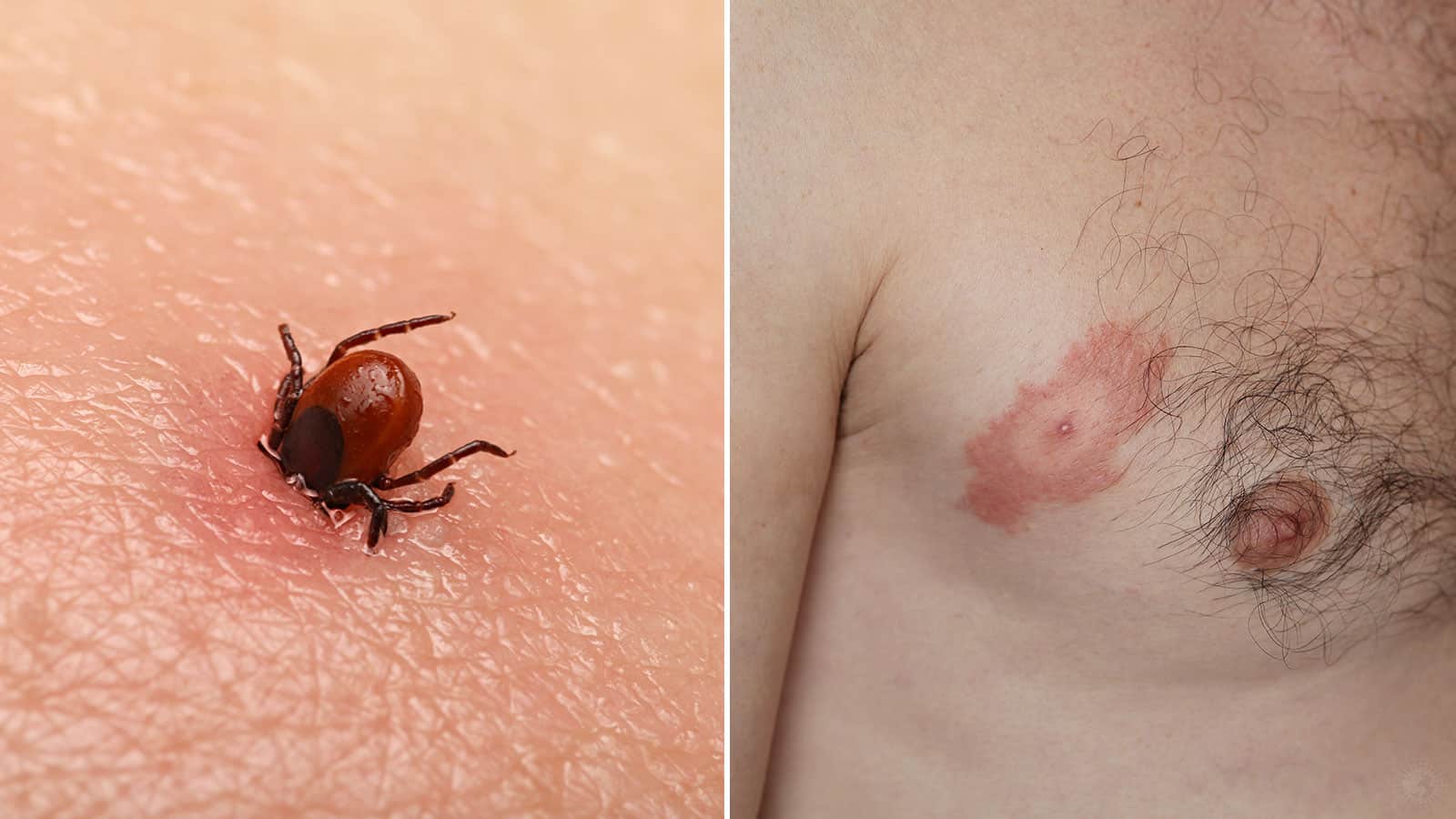If you have ever pulled a tick off your skin, you know they are positively disgusting. Ticks are more than just gross, though; tick bites can actually be dangerous. In some situations, tick bites can even prove fatal. Because of this, it is important to know how to deal with tick bites properly.
What is a tick?
The tick belongs to the arachnid family and is an external parasite. It lives off the blood of other live organisms. Most commonly, it lives off mammals like dogs and humans, but it can live off birds and reptiles as well.
What are the risks?
The risks posed by a tick bite are substantial. Tick-borne diseases include:
- Lyme disease
- Babesiosis
- Ehrlichiosis
- Anaplasmosis
- Tick-Borne Relapsing Fever
- Tularemia
- Rocky Mountain spotted fever
Lyme disease
Lyme disease is perhaps the most feared of all tick-borne diseases. The bacteria of the deer tick is what causes Lyme disease. Early signs of Lyme disease caused by ticks include:
- Fever
- Chills
- Rash
- Nausea and vomiting
- Facial paralysis
- Muscle weakness and soreness
- Headache
- Hearing loss
- Swollen lymph nodes
In the later stages of Lyme disease, sufferers may experience a persistent rash, inflammation of the eyes, and liver failure. In extreme cases, Lyme disease can lead to neurological problems or even death.
If you do contract Lyme disease from a tick bite, eating certain foods might help you recover more quickly.
Babesiosis
Babesiosis is a serious infection of the red blood cells that is caused by tiny parasites called Babesia. Fortunately, this illness is treatable. However, its severity ranges from asymptomatic to potentially fatal.
Symptoms of babesiosis include:
- Fever
- Fatigue
- Sweating
- Body aches
- Loss of appetite
- Chills
In some instances, babesiosis can progress into an even more serious condition called hemolytic anemia. People with hemolytic anemia lose red blood cells faster than their bodies can replace them. Hemolytic anemia can be fatal, but it can be cured if doctors can identify and treat the underlying factors.
Ehrlichiosis
Ehrlichiosis is less severe than Lyme disease and is usually spread by the Lone Star tick. Symptoms usually develop within two weeks; the most common symptoms are fever, confusion, headache, and chills. If you develop these symptoms within two weeks of a tick bite or after visiting an area with a high tick population, visit your doctor.
Anaplasmosis
Anaplasmosis, another tick-borne disease, usually manifests within two weeks of a tick bite. The symptoms of Anaplasmosis include fever, chills, muscle aches, and nausea. Anaplasmosis is treatable, most commonly with doxycycline, which is an antibiotic used to treat parasites and bacteria.
Tick-borne relapsing fever
Tick-borne relapsing fever (TBRF) is pretty much what it sounds like: a bacterial infection characterized by recurring fever, muscle aches, headaches, and nausea. TBRF is usually treated by injecting two grams of ceftriaxone daily for one to two weeks.
Tularemia
Tularemia is one of the more serious conditions that tick bites can cause. Flu-like symptoms will usually develop within five days, but they can take as long as two weeks to manifest. Symptoms of tularemia are sudden fever, progressive weakness, muscle aches, and other flu-like symptoms. Tularemia is usually treated with antibiotics, but it will get progressively worse if left untreated.
Rocky Mountain spotted fever
Rocky Mountain spotted fever (RMSF) is rare but extremely serious. Symptoms of RMSF include:
- A sudden high fever (up to 103 degrees Fahrenheit)
- Nausea
- Abdominal pain
- Muscle aches
- Poor appetite
- A red-spotted rash on the ankles, palms, wrists, and feet
The spotted rash is the most telltale sign of RMSF and is exhibited by at least 85% of people who contract the disease. If left untreated, a second rash, which is purple-red in color, develops and spreads toward the torso. This signals the disease’s progression and means the patient is at risk for meningitis, organ failure, and even death.
How to avoid tick bites
Most would agree that the best cure is prevention. You can help avoid tick bites by:
Covering as much of your skin as possible:
If you are going to be outdoors, cover as much of your body as you can. You should wear long pants and, if possible, long sleeves and tuck your pant legs into your socks.
Steering clear of tick-infested areas:
Ticks do not fly or jump. Instead, they like to wait on the tops of tall grass, bushes, and shrubs and attach themselves to organisms that wander by.
Wearing chemical repellents:
Wearing a DEET repellent can stop ticks from feeding on you. However, there are health risks associated with DEET repellents, and so some states currently ban them.
Checking you and your family members after an outing:
Whenever you return from outdoor activity, check yourself and your loved ones to make sure you did not pick up any ticks. It is crucial that you do this as soon as possible. Strangely, you are extremely unlikely to contract any diseases until a tick has been on your body for 36 hours.
Tick bite first aid
While it is preferable to avoid tick bites altogether, prevention is sometimes idealistic. Generally, bug bites simply have to run their course, but there are things you can do (and should not do) in terms of first aid for tick bites.
Dealing with the itch:
Bug bites are infuriatingly itchy, and tick bites are no exception. There are several good ways to deal with the itchiness associated with bug bites:
Applying cold compresses:
Applying cold compresses, like ice packs or crushed ice wrapped in a washcloth, will reduce inflammation and temporarily numb the area. Cold compresses can be slightly uncomfortable, but they are preferable to wanting to peel off your skin.
Taking oatmeal baths:
Oatmeal eases inflammation and creates a protective barrier around the epidermis. This relieves the itching caused by insect bites and also cleans your skin. People have been treating skin conditions with oatmeal since the 1800s
Resisting the urge to scratch:
This is a hard rule to follow, but the less you scratch an insect bite, the better off you are. Scratching insect bites is likely to cause infection. If the bite is already infected, scratching the area can spread the infection.
Taking antihistamines:
Histamines are natural substances your body produces in response to injuries or allergies. While your body’s intentions are good, histamines are often overproduced in response to bug bites, causing you to itch like crazy. Antihistamines quell this bodily response and relieve itching.
Using holistic remedies:
Not every effective treatment has to come from a drug company. If you like to avoid drugs whenever possible, things like aloe vera, witch hazel, and even onions can be effective.
Safe tick removal
If you find a tick on yourself or a family member, it is important that you remove them properly. According to the advice of the experts at the Centers for Disease Control and Prevention (CDC), these are the steps you should take to extract this parasite:
- Sanitize a pair of tweezers with rubbing alcohol.
- Use firm pressure to pull the bug straight up and out of your skin. Do not use a twisting motion, as you could break the insect, leaving part of it. If you need to coax it out, a gentle wiggling motion will free its grasp.
- Place the parasite into rubbing alcohol to kill it–never crush a tick. You might need to identify the species later. As unappealing as it sounds, you should save ticks you remove from your skin in a plastic bag or similar container. This way, you can show the little bloodsuckers to your doctor if you develop symptoms, which will help with diagnosis.
- Clean the impacted area with rubbing alcohol and pat it dry. Generally, bites heal up in just a few days.
Special Note: Do not attempt to burn ticks!
There is a popular myth that the best way to remove these parasites from your skin is to burn them. This is completely untrue.
Obviously, you could accidentally burn yourself, but burning a tick could also cause it to inject infected fluids into your body. Never attempt to burn a tick off your skin.
Final thoughts on removing ticks and first aid for bites
As scary as tick bites can seem, it is important not to jump to the worst assumptions. The vast majority of tick bites do not result in disease or infection. Most people who suffer a tick bite will never experience any symptoms. In fact, many of them will never even know that a tick bit them at all.
Additionally, most tick-borne diseases are curable with antibiotics. That means that if you are bitten by a tick, nothing is likely to come of it, especially if you remove the tick within 36 hours. Even if you do contract a tick-borne disease, it is highly likely that the infection will run its course, and you will fully recover.
The most critical thing to remember about ticks is that they are usually unable to do much harm if they are promptly removed. As such, it is crucial that you are diligent about checking yourself and your children after any outdoor adventures.

















 Community
Community

